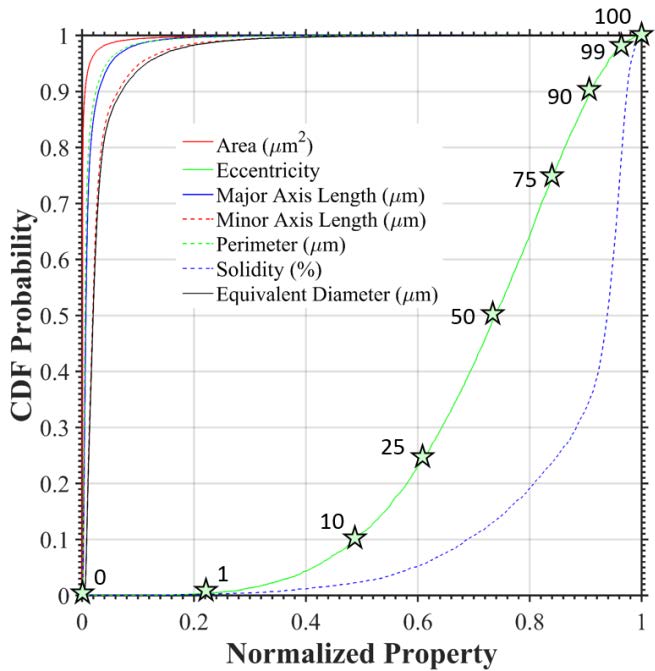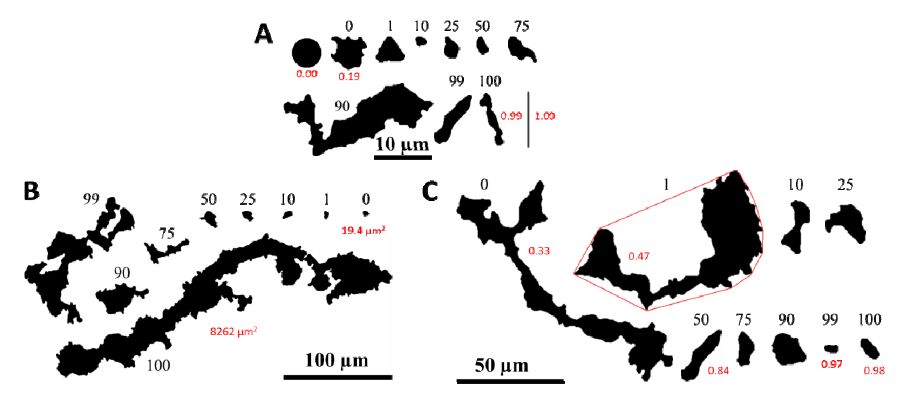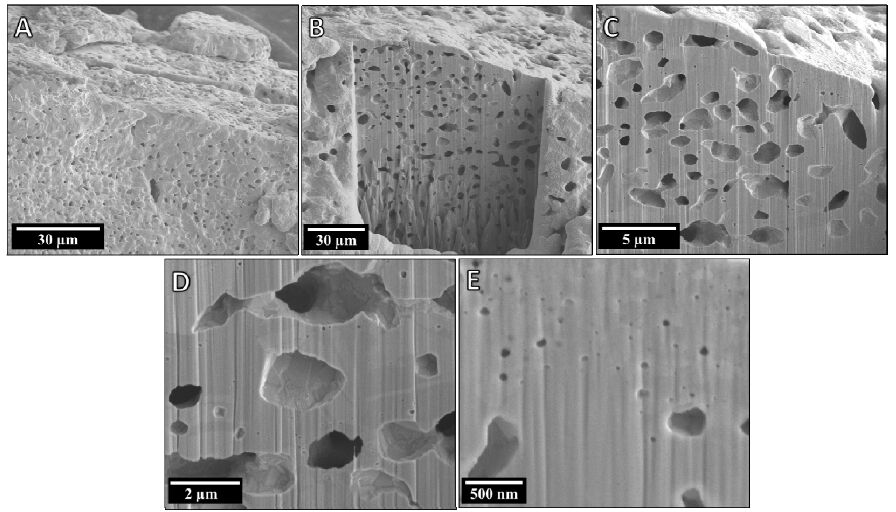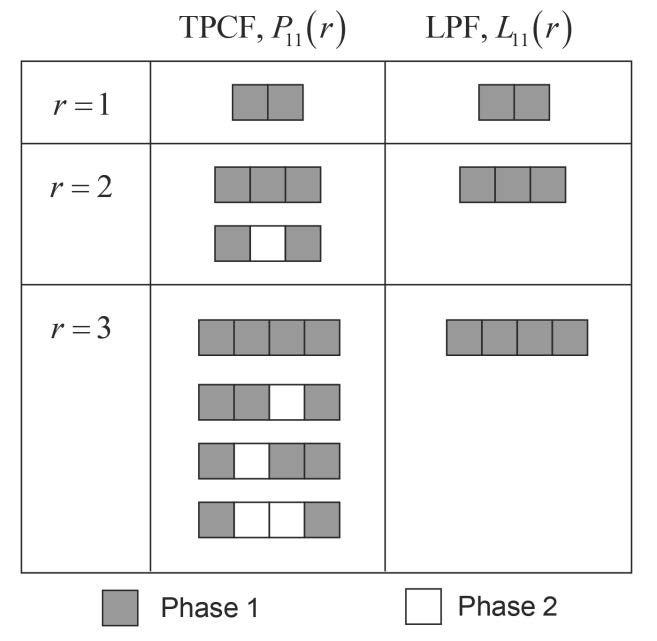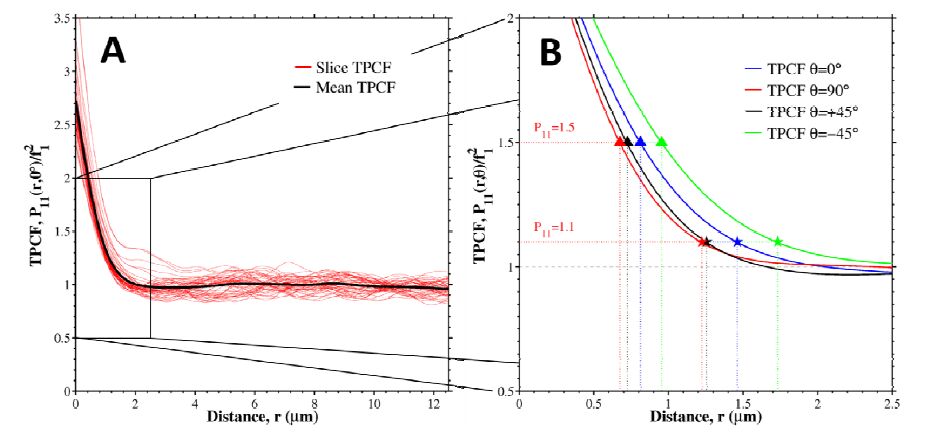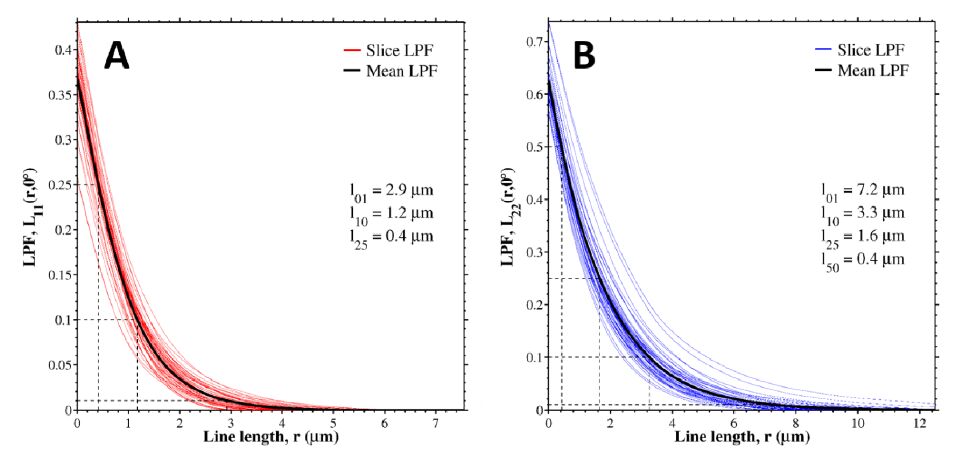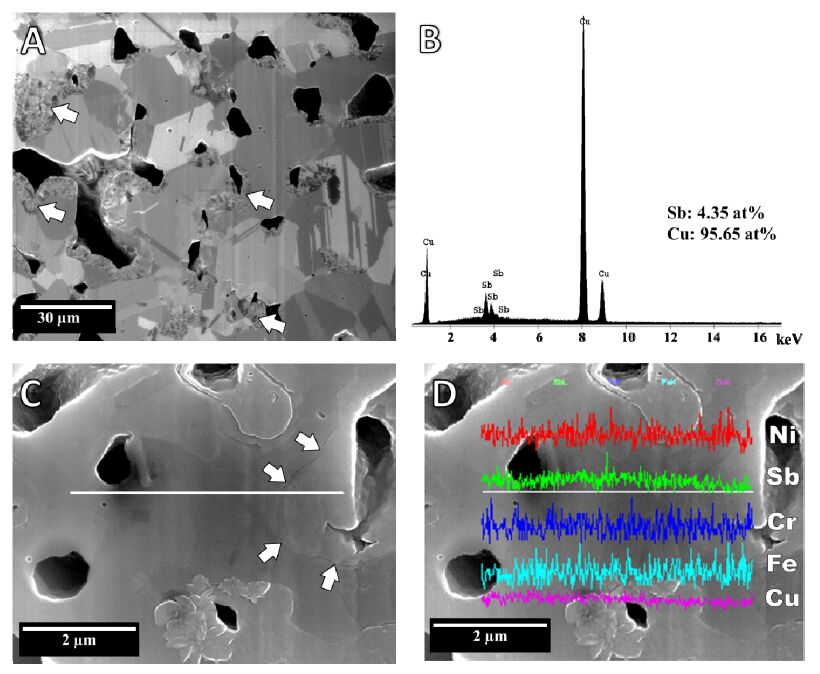Porous metals can be created through a wide variety of processing techniques, and the pore morphology resulting from these processes is equally diverse. The structural and functional properties of metal foams are directly dependent on the size, shape, interconnectedness and volume fraction of pores, so accurately quantifying the pore characteristics is of great importance. Methods for analyzing porous materials are presented here and applied to a copper-based metallic foam generated through solid state foaming via oxide reduction and expansion. This process results in large voids (10s of microns) between sintered particles and small pores (10 microns to less than 50 nm) within particles. Optical and electron microscopy were used to image the porosity over this wide range, and the pore characteristics were quantified using image segmentation and statistical analysis. Two-dimensional pore analysis was performed using the Chan-Vese method, and two-point correlation and lineal path functions were used to assess three-dimensional reconstructions from FIB tomography. Two-dimensional analysis reveals distinct size and morphological differences in porosity between particles and within them. Three-dimensional analysis adds further information on the high level interconnectedness of the porosity and irregular shape it takes, forming tortuous pathways rather than spherical cells. Mechanical polishing and optical microscopy allow large areas to be created and analyzed quickly, but methods such as focused ion beam (FIB) sectioning can provide additional insight about microstructural features. In particular, after FIB milling is used to create a flat surface, that surface can be analyzed for structural and compositional information.
1.
Introduction
Tungiasis is a parasitic skin condition brought on by female sand fleas and is sometimes referred to as jiggers or sand flea infestation. Tropical and subtropical regions, especially the regions of America, Asia, Africa and the Caribbean, are infected with this disease. The flea enters into the skin, usually in areas where the skin is thin, such as the toes, heels and the spaces between toes and fingers [1]. The female sand flea burrows into the skin and grows into a small, swollen, and painful lesion, often resembling a tiny white or black dot. The flea then lays eggs inside this lesion and after development to complete the life cycle. The primary symptom of tungiasis is intense itching, leading to scratching, which can cause secondary bacterial infections. The affected area may become red, swollen, and painful. Over time, the lesions may grow larger and more uncomfortable [2]. Tungiasis is usually diagnosed based on clinical signs and symptoms. The presence of a specific lesion in the toes or feet, especially in areas with a history of sand flea infestations, helps with diagnosis [3]. The most effective treatment for tungiasis is the removal of the embedded sand fleas using sterilized instruments or a needle. The lesion should be cleaned and disinfected to prevent infections. In severe cases, topical antibiotics may be prescribed if secondary infections have developed [4]. Preventive measures include avoiding walking barefoot in sandy or contaminated areas and wearing protective footwear.
Surgical extraction of embedded sand fleas under sterile medical conditions [5] can also be considered an efficacious therapeutic approach for its management. Tungiasis is a preventable condition, but it can cause significant discomfort and complications if left untreated [6]. If you suspect you have tungiasis or are experiencing symptoms, it is essential to seek medical attention for proper diagnosis and treatment. The infected areas often experience subpar living conditions and inadequate sanitation, making the inhabitants particularly susceptible to the infestation [7]. The afflicted populations face serious health and economical difficulties as a result of this neglected tropical illness. The mechanics of tungiasis transmission must be understood in order to adopt effective control measures and lessen the disease's effects. Jiggers, chigoe flea infection, and pulex penetrans infestation are a few of the historical names for tungiasis [8]. The female sand flea that transmits the disease burrows into the skin, concentrating on the feet, causing painful sores, inflammatory reactions, and secondary infections if left untreated.
Mathematical models have significantly contributed to enhancing comprehension of the fundamental mechanisms of biological processes for public health [9]–[15]. Over the years, researchers and public health experts have dedicated significant efforts to gain insight into the spread of various infections [16]. Previous research has concentrated on a variety of disease-related topics [17], [18], from clinical symptoms and epidemiology to control methods and therapies. The frequency and geographic distribution of tungiasis have been examined in studies, revealing insight on the disease's burden and its effects on afflicted people [19], [20]. Kahuru et al conducted a study focused on employing an optimal control approach within a mathematical model to analyze the dynamics of tungiasis within a community [21]. The researchers in [22] established the stability results of the transmission dynamics of the disease. After that, the theory of optimal control is utilized, all with the ultimate goal of reducing the numbers of infested humans, infested animals, and sand flea populations [23]. The processes of disease transmission and the potential effects of interventions like better sanitation, health education, and treatment campaigns have both benefited greatly from these modeling studies [24]. Mathematical modeling of infectious diseases enhances our understanding of the diseases, facilitates evidence-based decision-making, and helps implement targeted interventions to reduce the burden of the condition in affected communities. In this work, we will enhance our scientific comprehension of tungiasis dynamics to provide more valuable perspectives for efficient management approaches. Through the utilization of mathematical modeling and simulation methods, we will evaluate the prospective consequences of treatments and facilitate decision-making within the realm of public health to improve the effectiveness of interventions and control measures.
Fractional calculus is a branch of mathematics that deals with derivatives and integrals of non-integer orders. It extends the concepts of traditional calculus, which involves integer-order derivatives and integrals. Fractional calculus has found applications in various scientific fields [25]–[30], including epidemiology, where it can be used to model the spread of infectious diseases. It has been acknowledged that fractional calculus offers a more flexible framework for describing complex real-world problems [31], [32]. The Atangana-Baleanu fractional derivative is a type of fractional derivative that has been applied to various mathematical models, including epidemic models [33], [34]. Fractional calculus generalizes the concept of traditional derivatives and integrals to non-integer orders, allowing for a more flexible representation of complex phenomena, such as anomalous diffusion or power-law behaviors [35]. In the context of epidemic models, the Atangana-Baleanu fractional derivative has been utilized to introduce memory effects and long-range interactions into the system. In addition to this, these models can capture more realistic scenarios and provide insights into the long-term behavior of infectious diseases. Hence, we choose to represent the dynamics of tungiasis using a fractional framework to obtain more precise results.
This article is organized as follows: The fundamental concepts and results of the fractional theory related to the ABC operator is presented in Section 2. In Section 3, we formulated a mathematical model for tungiasis through the ABC operator in the fractional framework. In Section 4, the suggested model is subsequently examined. In Section 5, the solution of the recommended model is investigated with the help of fixed-point theory. Then, we introduced a numerical scheme to highlight the dynamical behaviour of the system in Section 6. Finally, ending remarks of the work are presented with future work in Section 7.
2.
Preliminaries of fractional-calculus
The main relevant findings and definitions of classical Caputo[36] and Atangana-Baleanu fractional derivatives[37] will be presented here and will be useful in the following portion of the paper.
Definition 2.1. Let $f:[p,q]\rightarrow \mathbb{R}$ be a given function, then the fractional derivative of Caputo fractional derivative of order j is given by
for j∈(n−1,n), where n∈Z.
Definition 2.2. The Atangana-Beleanu fractional derivative for a given function f in the Caputo form is introduced as
where f∈H1(p,q), q > p, and j∈[0,1]. In addition to this, B(j) is the normalization function which satisfies the condition B(0) = B(1) = 1.
Definition 2.3. The integral of the ABC derivative is denoted by ABCpIjtf(t) and is defined as:
Theorem 2.1. Assume f in a manner that f∈C[p,q], then we have the equation below mentioned in [37]:
Furthermore, it has been established that ABC derivatives satisfy the Lipschitz condition [37].
3.
Evaluation of the dynamics
Here we present a mathematical model of Tungiasis disease. In this approach, the total population is divided into four categories: group that practices good hygiene ($\mathcal{P}$), susceptible ($\mathcal{S}$), infected ($\mathcal{I}$), and treated ($\mathcal{T}$) groups. Then, the total population is
At birth, the population that is most susceptible is recruited at a rate of (1−γ)υ, whereas the group that practices good hygiene is recruited at γυ where υ represents the rate of recruitment at birth and γ represents the likelihood of being recruited into the category of good hygiene practices. The appropriate hygiene practice group ($\mathcal{P}$) develops susceptibility ($\mathcal{S}$) at a rate of φ. Individuals from the class ($\mathcal{S}$) move to the class ($\mathcal{I}$) with a rate Г. The infected individuals ($\mathcal{I}$) transfer to the treated group ($\mathcal{T}$) at a rate of ρ following therapy. We indicated the natural death rate by µ. The infection rate Г is defined as
where ϵ is the contact rate with infected people and σ is the likelihood of being infected after repeated exposure to infected people. Then our model with the above assumptions for tungiasis disease is as follows:
with appropriate initial condition
It is acknowledged that epidemic models through the Atangana-Baleanu fractional derivative can more accurately represents the dynamics of infectious diseases than conventional integer derivatives. This inclusion enables a more comprehensive exploration of epidemic spread in intricate settings characterized by long-range interactions and memory effects, fostering an improved comprehension of the underlying mechanisms. Consequently, the refined insights gained from these fractional derivative-based models hold the potential to enhance the precision of epidemic predictions and facilitate the development of more efficacious control strategies. Nonetheless, it is crucial to acknowledge that the introduction of fractional derivatives into mathematical models may introduce increased system complexity, necessitating the utilization of specialized mathematical and numerical techniques for rigorous analysis and simulation. Thus, the model (3.1) recommended above can be written in fractional form as
All of the parameters in the recommended model (3.1) for tungiasis disease are considered to be positive. Furthermore, the term ABC0Djt in the above model indicates the ABC derivative. The effects of memory which arise in the epidemiological process but are not incorporated in the classical operators, are the driving force behind fractional order models. In Table 1, we illustrated the parameters of the recommended model with description.
4.
Analysis of the model
In this section, we deal with some analysis of the model, like steady-state analysis, and find the basic reproduction ratio $\mathcal{R}_0$ for the above model (3.3). As the system (3.3) models the population of humans, all state variable solutions with nonnegative beginning conditions are nonnegative ∀t>0 and have a feasible region bound as follows:
In the upcoming step, we will focus on the steady-states of the suggested system of the infection. First, we take the following:
then, the model (3.3) becomes
The disease-free equilibrium of an epidemic model refers to a stable state where the infectious disease has been eliminated from the population. Understanding the disease-free equilibrium is essential in assessing the effectiveness of control strategies and vaccination programs. It serves as a benchmark to measure the success of public health interventions in eliminating or controlling infectious diseases and preventing outbreaks. For the infection-free steady-state, we set
Thus, we have
The endemic equilibrium (EE) of an epidemic model refers to a stable state where the prevalence of the infectious disease remains constant over time. Understanding the endemic equilibrium of an epidemic model is crucial in assessing the long-term behavior of the infection and evaluating the quality of control measures in maintaining the disease at a manageable level. It provides valuable insights into the stability and persistence of the infection in a population and is a fundamental concept in the study of infectious disease dynamics. We indicate the EE of the system by (E*) and substitute $\Gamma=\frac{\sigma\varepsilon\mathcal{I}}{\mathcal{N}}$. Then from (4.1), we have
Solving the above system (4.2), we have
The basic reproduction number is a fundamental concept in epidemiology that quantifies the potential of an infection to spread. It represents the average number of secondary infections generated by a single infected individual in a fully susceptible environment. If the basic reproduction number is less than 1, it means that, on average, each infected individual will cause fewer than one new infection during their infectious period. In this case, the disease will not be able to sustain itself in the population, and it will eventually die out. If this parameter is equal to 1, this implies that, on average, each infected individual will cause exactly one new infection during their infectious period. The disease will reach a stable endemic equilibrium, where the number of new infections is balanced by the number of recoveries, resulting in a constant prevalence of the disease in the population. If this parameter is greater than 1, this implies that each infected individual, on average, will cause more than one new infection during their infectious period. In this case, the disease has the potential to spread, and if left uncontrolled, it may lead to an epidemic outbreak.
We symbolized this number as $\mathcal{R}_0$ and calculate it through the next-generation matrix method [38]. We take the infected class of the system (3.1), so we have
Let F be the matrix containing parameters that are entering into infected class and V be the matrix containing those parameters that leave infected classes while neglecting the negative signs, so we get
and
This implies that $\mathcal{R}_0= \dfrac{\sigma\varepsilon}{\omega+\varrho+\mu}$, which is the required $\mathcal{R}_0$ of the recommended system.
Theorem 4.1. For j = 1, the infection-free steady-state E0 of the system (3.3) is locally asymptotically stable if $\mathcal{R}_0<1$, otherwise it is unstable.
Proof. Let j = 1 and take the Jacobian matrix of the model (3.3) at infection-free steady-state E0 as
The above Jacobian matrix has the following characteristic equation:
furthermore, we have
and simplifying, we have
which implies that λ1=−(ϕ+µ) and
the simplification of which implies that
From the above, we have λ2=−µ and
Hence, all the eigen values are negative. Furthermore, we have $\mathcal{J}_1(E_0)$ given by
To show the required result, we have to show that Tace($\mathcal{J}_1(E_o))<0$ and Det($\mathcal{J}_1(E_o))>0$, so
which implies that
Also, we have
Because $\mathcal{R}_0<1$ is given, so the Det will be positive, that is, $Det(\mathcal{J}_1(E_0))>0.$ Hence, the infection-free steady-state of the recommended system is locally asymptotically stable (LAS) for $\mathcal{R}_0<1$ and unstable in other cases.
Theorem 4.2. For j = 1, the endemic steady-state (E*) of system (3.3) is LAS if $\mathcal{R}_0>1$ and is unstable in other circumstances.
Proof. Let j = 1 and take the Jacobian matrix of system (3.3) at endemic steady-state (E*) as
furthermore, we get
in which $W= \frac{1}{\left(\omega+\varrho+\mu\right)}\left[\frac{(\varphi-\gamma\mu+\mu)\upsilon}{(\varphi+\mu)} - \frac{\mathcal{N}^*\mu(\omega+\varrho+\mu)}{\sigma\varepsilon}\right].$ The characteristic equation is $(\varphi+\mu+\lambda)(\mu+\lambda)\left[\lambda^2+ \left(\frac{\sigma\varepsilon W}{\mathcal{N}^*}+\mu\right)\lambda+ \frac{\sigma\varepsilon(\omega+\varrho+\mu) W}{\mathcal{N}^*} \right]=0,$ which implies that λ1=−(ϕ+µ) and λ2=−µ with the following
Substituting the value of W into (4.4), we get
in which $m=\frac{\mathcal{R}_o((\varphi-\gamma\mu+\mu)\upsilon)}{(\varphi+\mu)\mathcal{N}^*}$ and $n=\frac{\sigma\varepsilon(\varphi-\gamma\mu+\mu)\upsilon}{(\varphi+\mu)\mathcal{N}^*} - (\omega+\varrho+\mu)\mu .$ Hence it is clear that m,n>1, also $\mathcal{R}_0=\frac{\sigma\varepsilon}{\omega+\varrho+\mu} > 1.$ The eigenvalues provided by equation (4.5) are negative according to the Routh-Hurwitz criteria. Thus, whenever $\mathcal{R}_0 > 1$, the EE of the proposed model of tungiasis is locally asymptotically stable.
5.
Fractional order model solution
In this section of the paper, we utilize fixed point theory to demonstrate the existence and uniqueness of the fractional order model (3.3) solution. The system of equations can be represented in the following way:
In the above (5.1), $v(t)=(\mathcal{P}, \mathcal{S}, \mathcal{I}, \mathcal{T})$ is the vector form of the state variables and $\mathcal{U}$ is a continuous vector function. Moreover, $\mathcal{U}$ is given by
and $v_0(t)=\left(\mathcal{P}(0), \mathcal{S}(0), \mathcal{I}(0), \mathcal{T}(0)\right)$ are initial conditions. In addition to this, the Lipschitz condition is fulfilled by $\mathcal{U}$ as
In the upcoming step, the existence and uniqueness of the fractional order dynamical model (3.3) will be proved.
Theorem 5.1. The solution of fractional order (FO) model of equations (3.3) will be unique if the below mentioned condition satisfies:
Proof. In order to demonstrate the desired result, we utilize the Atangana-Beleanu (AB) fractional integral, as defined in (2.3), on system (5.1). This yields a non-linear Volterra integral equation as follows:
Take $ I=(0, T)$ and the operator $\Phi:\mathcal{G}(I,R^4)\rightarrow \mathcal{G}(I,R^4)$ defined by
Equation (5.4) takes the following form
and the supremum norm on I is indicated by $\|.\|_I$ and is
Certainly, $\mathcal{G}(I,R^4)$ with norm $\|.\|_I$ becomes a Banach space and
with $v(t)\in \mathcal{G}(I,R^4)$, $\mathcal{F}(t,\kappa)\in \mathcal{G}(I^2,R)$ in a manner that
Here, utilizing the definition of Φ shown in (5.6), we have
Additionally, by applying the Lipschitz condition (5.2) and the triangular inequality, in combination with the result in (5.8), we arrive at the below expression after simplification:
Consequently, we have the following:
in which
It is evident that when condition (5.3) is met, Φ becomes a contraction, implying that the fractional order dynamical system (5.1) possesses a unique solution.
6.
Iterative scheme and results
In this section, we will present an iterative scheme for the numerical solution of the recommended model (3.3) of the infection. First, an iterative scheme will be developed and then the the solution pathways of the system will be represented through the scheme to understand the dynamics. We use the newly established numerical approach (iterative) proposed for the approximation of the AB integral operator [39]. We briefly describe and apply the aforesaid approach to our dynamical system (3.3) in order to show the impact of different parameters on the infection.
Here, rewriting system (5.4) of the infection into the fractional integral equation form using the fundamental theorem of fractional calculus:
At t=tξ+1, ξ=0,1,2,..., we have
The function $\mathcal{U} (\kappa,s(\kappa))$ can be estimated over the interval [tj,tj+1], and we apply the interpolation polynomial
then substituting in (6.2), we get
After computing these integrals, the approximate answer is as follows:
Finally, for the suggested model, we achieved the following recursive formulae:
We will utilize the above alterative approach to investigate the dynamical behaviour of the recommended fractional model of tungiasis. It is well-known that the graphical view analysis of epidemic models provide a comprehensive exploration of the model's behavior, leading to a better understanding of the epidemic's spread and potential control strategies. Here, we will perform different simulations to visualize the impact of different input factors on the system.
The values of the input parameter and state variables of the system are assumed for numerical purposes. For our investigation, we conducted a series of simulations to analyze the behavior of the system under different conditions. In these simulations, we varied specific parameters and observed their impact on the solution pathways of the system. First, in Figure 1 and Figure 5, we examined the effect of the fractional parameter j on the dynamics of the system. By changing the fractional order, we aimed to understand its role in shaping the infection spread in the society. Notably, we observed that decreasing the fractional parameter led to a reduction in the infection rate within the community. This finding indicates that the fractional parameter can serve as a crucial control parameter for managing the epidemic. In Figure 2, we focused on the losing rate of protection and its influence on the dynamics of the tungiasis infection. The results clearly indicate that this parameter plays a pivotal role in determining the risk of infection within the population. A higher losing rate of protection was found to increase the susceptibility to infection, posing a potential threat to public health.
The treatment rate was the primary parameter of interest in Figure 3. By varying the treatment rate ρ, we explored its impact on the transmission dynamics of the system. The simulation revealed that the treatment rate significantly affects the control of the infection. Higher values of ρ demonstrated a more effective reduction in infection rates, suggesting its importance in implementing effective intervention strategies. Lastly, Figure 4 focused on understanding the influence of the transmission probability on the tungiasis dynamics. Through this simulation, we visualized how changes in the transmission probability affect the overall dynamics of the infection. The results clearly illustrated that the transmission probability is a critical factor in shaping the infection spread within the community.
Our numerical analysis provided valuable insights into the control and dynamics of tungiasis. The fractional parameter, losing rate of protection, treatment rate, and transmission probability all emerged as significant factors that influence the infection's behavior. In the realm of tungiasis control and intervention, our discovered insights provide a foundational framework for the formulation of effective strategies aimed at managing and mitigating the spread of the infection within affected populations. It is, however, crucial to acknowledge that the values employed in this analysis were assumptions crafted for numerical expediency and may not faithfully replicate real-world scenarios. Consequently, for heightened precision in predictions and practical implications, an imperative next step involves the meticulous validation and refinement of our model using authentic real-world data. This process is indispensable for aligning our theoretical framework with the intricacies of tangible scenarios and enhancing the applicability of our findings in the context of tungiasis control and management.
7.
Conclusion
In this study, we formulated an epidemic model for tungiasis disease in the framework of fractional Atangana-Baleanu derivative to conceptualize the transmission route of the infection. The biologically meaningful steady-states of the system are investigated through analytic methods. We determined the basic reproduction number of our fractional model, symbolized by $\mathcal{R}_0$. The existence and uniqueness of the model's solution has been demonstrated. We have shown that the infection-free steady-states of the recommended model are locally asymptotically stable if $\mathcal{R}_0<1$ and unstable in other cases, while the endemic steady-state is locally asymptotically stable if $\mathcal{R}_0>1$ and unstable in other circumstances. A numerical scheme is presented to illustrate the solution pathways of the recommended system of the infection. The dynamical behaviour of the model is presented with the variation of different input parameters. We recommended the most critical factors of the system for the control and subsequent of tungiasis. It is acknowledged that delays play a fundamental role in capturing the temporal dynamics of systems [40]. Incorporating delays into mathematical models enhances their predictive power and allows for a more accurate representation of real-world phenomena [41]–[43]. In the future work, we will incorporate time delay in the transmission dynamics of the disease to comprehend the dynamics of the disease and provide more accurate information for prevention.
Use of AI tools declaration
The authors declare they have not used Artificial Intelligence (AI) tools in the creation of this article.









 DownLoad:
DownLoad:









